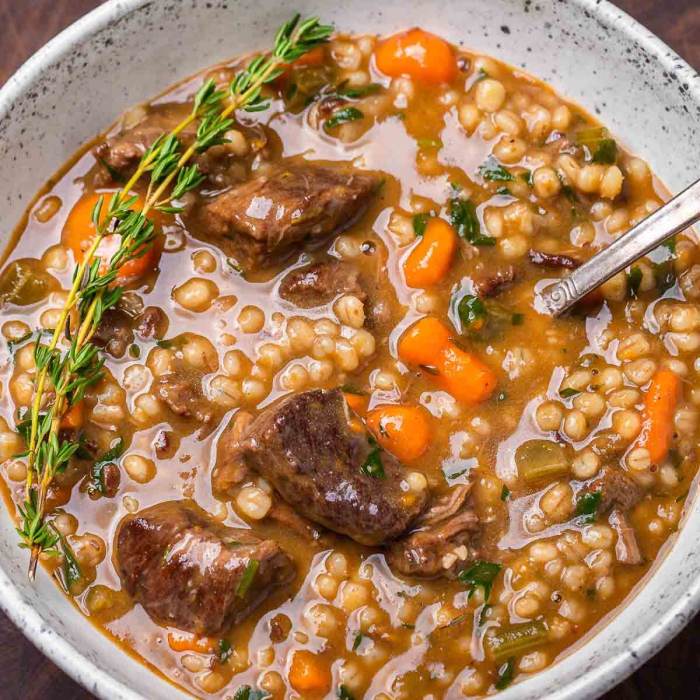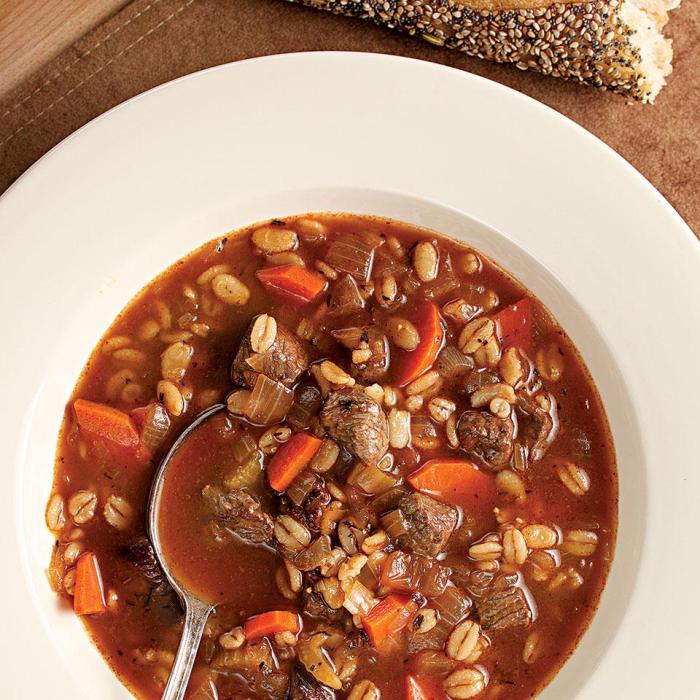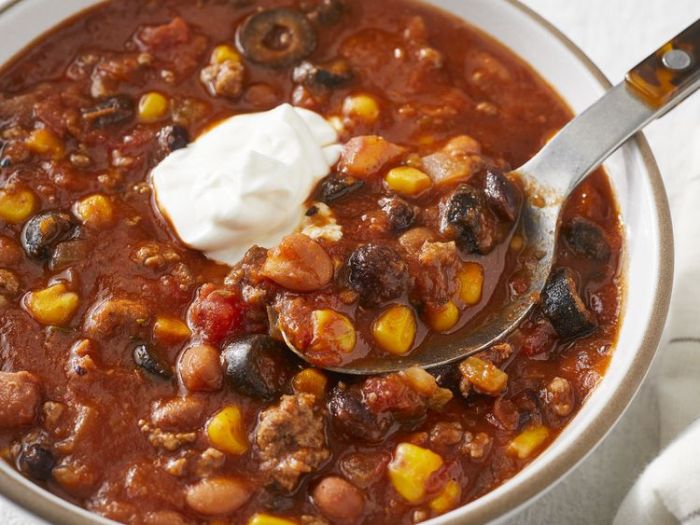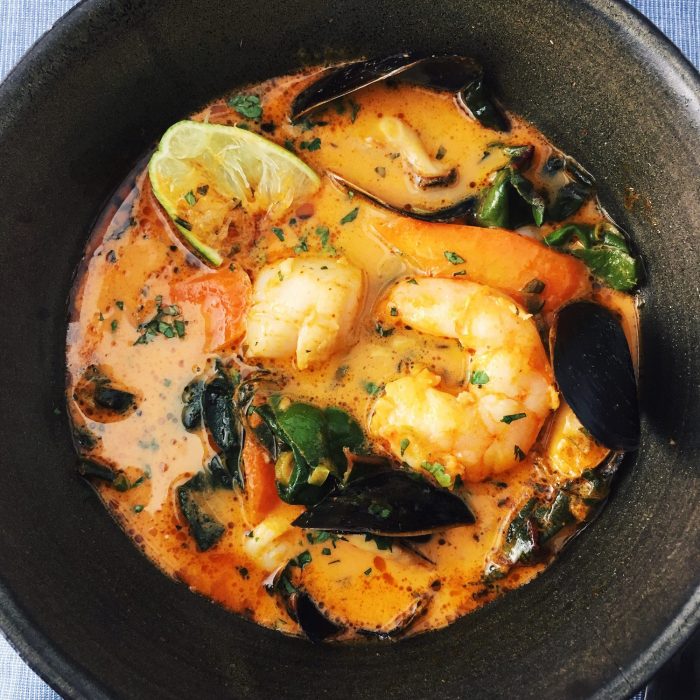Beef and Barley Soup: A Comprehensive Guide: Recipe For Beef And Barley Soup

Source: sipandfeast.com
Recipe for beef and barley soup – Beef and barley soup, a hearty and comforting classic, offers a versatile canvas for culinary creativity. This guide explores various aspects of this beloved dish, from recipe variations and ingredient exploration to flavor enhancements and serving suggestions. We will delve into the nuances of cooking methods, nutritional profiles, and dietary adaptations, providing you with a comprehensive understanding of this timeless recipe.
Recipe Variations
Three variations of beef and barley soup are presented below, each utilizing a different cooking method: slow cooker, stovetop, and pressure cooker. This allows for flexibility based on your time constraints and equipment availability. A comparison of their nutritional profiles and cooking times follows.
| Method | Ingredients | Summary | Serving Suggestions |
|---|---|---|---|
| Slow Cooker | Beef stew meat, barley, carrots, celery, onion, beef broth, bay leaf, thyme, salt, pepper. | Low and slow cooking yields incredibly tender beef and a deeply flavorful broth. | Serve with crusty bread for dipping, a side salad, or a dollop of sour cream. |
| Stovetop | Similar ingredients to slow cooker version. | Requires more hands-on attention but allows for adjustments throughout the cooking process. | Pair with a simple green salad or roasted vegetables. |
| Pressure Cooker | Similar ingredients to slow cooker version. | Fastest cooking method, resulting in tender beef and barley in a fraction of the time. | Excellent as a quick weeknight meal, served with cornbread or biscuits. |
Nutritional Profile Comparison:
While the exact nutritional content varies depending on the specific ingredients and quantities used, generally, the slow cooker and stovetop versions will have similar calorie counts and macronutrient profiles. The pressure cooker version might show slightly lower calorie counts due to reduced cooking time and potential for less liquid absorption. Protein content will be relatively consistent across all three methods, primarily derived from the beef.
Fiber content will also be similar, largely contributed by the barley and vegetables.
Visual Representation of Cooking Times:
A simple bar graph could effectively represent the cooking times. The x-axis would list the three cooking methods (slow cooker, stovetop, pressure cooker), and the y-axis would represent cooking time in hours. The bars would be colored differently (e.g., slow cooker – dark brown, stovetop – medium brown, pressure cooker – light brown) to visually distinguish the methods. The length of each bar would correspond to the approximate cooking time for each method, clearly showing the pressure cooker’s significantly shorter cooking time compared to the slow cooker.
Ingredient Exploration
Understanding the key ingredients is crucial to mastering beef and barley soup. This section explores the role of barley, the types of beef suitable, and the common vegetables used.
Barley’s Role:
Barley adds a nutty flavor and chewy texture to the soup. It’s a good source of fiber and provides a hearty base. Pearl barley is commonly used for its faster cooking time compared to hulled barley.
Beef Selection:
Several cuts of beef work well in this soup. Chuck roast is a popular choice due to its affordability and ability to become incredibly tender with long cooking times. Short ribs provide rich flavor and melt-in-your-mouth tenderness. Brisket, while requiring longer cooking, offers a robust beefy flavor.
Vegetable Additions:
- Early Addition: Onions, carrots, celery (these form the base flavor and soften during the longer cooking time)
- Mid-Addition: Potatoes, parsnips (added midway to prevent overcooking)
- Late Addition: Peas, green beans (added towards the end to retain their vibrant color and texture)
Flavor Profiles and Enhancements
Spices and herbs play a significant role in shaping the flavor profile of beef and barley soup. This section explores various options and how to achieve different taste preferences.
Spices and Herbs:
Bay leaves, thyme, rosemary, and parsley are classic additions, lending an earthy and herbaceous note. A pinch of smoked paprika adds depth and smokiness. Garlic and onion powder enhance the savory flavors.
| Flavor Profile | Ingredient Adjustments | Description |
|---|---|---|
| Hearty | Increase the amount of barley and add more root vegetables like potatoes and parsnips. | A robust and filling soup with a substantial texture. |
| Subtly Sweet | Add a touch of brown sugar or maple syrup and increase the amount of carrots. | A balanced sweetness complements the savory beef and barley. |
| Spicy | Incorporate a pinch of cayenne pepper, a dash of hot sauce, or some diced jalapeños. | Adds a kick of heat to the soup. |
Dietary Adaptations:
For a vegetarian version, substitute the beef with hearty vegetables like mushrooms, lentils, or beans. For a gluten-free version, ensure that the barley used is certified gluten-free, as some barley products may contain gluten.
Serving and Presentation, Recipe for beef and barley soup

Source: media-allrecipes.com
The presentation of your beef and barley soup can significantly enhance the dining experience. This section provides suggestions for visually appealing presentation and serving styles.
Visual Appeal:
Garnish the soup with fresh herbs like parsley (bright green, delicate texture, slightly peppery flavor) or chives (vibrant green, fine texture, mild onion flavor). A swirl of cream or a sprinkle of grated Parmesan cheese (creamy texture, sharp/savory flavor) adds visual interest and richness. A sprinkle of toasted barley adds textural contrast and visual appeal.
Serving Styles:
- Main Course: Serve in a bowl with crusty bread for dipping.
- Buffet: Offer in a large crockpot or chafing dish, allowing guests to serve themselves.
- Side Dish: Serve in smaller bowls as an accompaniment to grilled meats or sandwiches.
Recipe Card Design:
A recipe card would typically include the title (“Beef and Barley Soup”), serving size (e.g., 6 servings), prep time (e.g., 20 minutes), cook time (depending on the method, e.g., 4-8 hours for slow cooker), ingredients list, and step-by-step instructions. It could also include a small image or illustration of the finished soup.
Storage and Reheating

Source: tasteofhome.com
Proper storage and reheating techniques are crucial to maintaining the quality and flavor of your beef and barley soup.
Storage:
Allow the soup to cool completely before storing it in airtight containers (glass or food-grade plastic). Store in the refrigerator for up to 4 days or in the freezer for up to 3 months.
Reheating:
Gently reheat the soup on the stovetop over low heat, stirring occasionally to prevent scorching. Avoid boiling, as this can alter the texture and flavor. Microwave reheating is also an option, but it’s essential to stir frequently to ensure even heating.
Changes During Reheating:
Reheating can lead to slight thickening of the soup and a potential loss of some flavor intensity. To minimize these changes, reheat gently and avoid prolonged exposure to high heat. Adding a little extra broth if the soup becomes too thick can help restore its consistency.
General Inquiries
Can I use frozen vegetables in this soup?
Yes, frozen vegetables work well. Add them during the last 15-20 minutes of cooking time to ensure they don’t become mushy.
How long can I store leftover soup?
Leftover soup can be stored in an airtight container in the refrigerator for up to 3-4 days.
Can I make this soup ahead of time?
A hearty beef and barley soup is a classic comfort food, perfect for a chilly evening. For a lighter yet equally satisfying alternative, consider trying a different type of soup altogether, such as the delicious potato gnocchi soup recipe found online. However, if you’re craving that robust beefy flavor, then a well-seasoned beef and barley soup remains an excellent choice.
Absolutely! This soup actually tastes even better the next day. Make it a day or two in advance and reheat before serving.
What if I don’t have barley?
You can substitute other grains like rice, quinoa, or even small pasta shapes. Adjust cooking time as needed.


